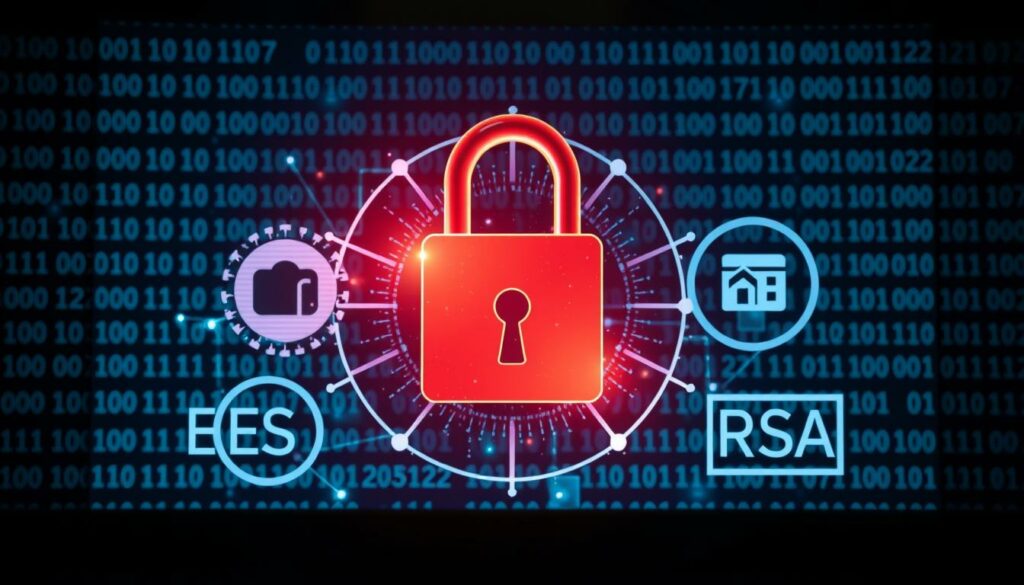How To Encrypt a File in Linux: Secure Your Data
Keeping your data safe is key in today’s digital age. Linux has strong tools for encrypting files, making it a top choice for protecting your information. This guide will show you how to use different encryption methods in Linux.
Linux can encrypt text files, documents, and images. We’ll look at both command line and graphical tools. This way, both tech experts and beginners can find a method they like.
First, you need to install the right software. We’ll help you set it up and suggest testing it on non-important files first. This step helps you familiarize yourself with the process before using it on important data.
By the end of this 6-minute read, you’ll know a lot about encrypting files in Linux. We’ll cover key topics like choosing the right key size and managing password caches. Let’s start making your files safe with Linux’s strong encryption.
Introduction to File Encryption in Linux
File encryption makes data unreadable without a decryption key, protecting sensitive information from unauthorized access. Linux provides versatile tools like GnuPG and OpenSSL for encrypting text files, documents, and images. For those needing whole-disk encryption, solutions like LUKS are ideal. Mastering these tools is essential for safeguarding your digital privacy.
What Is File Encryption?
File encryption scrambles data using algorithms, ensuring it remains secure until decrypted with the right key. Public-key cryptography underpins modern encryption methods like TLS and PGP. Encryption is crucial for securing data in transit, on external devices, or across entire disks.
Popular Encryption Tools for Linux
Linux users can use strong encryption tools to keep their data safe. These tools have many features to protect files and disks. They meet different needs and preferences. Let’s look at some top encryption solutions for Linux systems.
- GnuPG (GPG): GnuPG, or GPG, is a widely used open-source tool for encrypting files and emails on Linux. It supports both symmetric and asymmetric encryption, making it ideal for securing data. Often chosen for signing packages and securing messages, it serves as a strong alternative to Symantec’s PGP.
- OpenSSL: OpenSSL is a robust tool for encrypting files and networks on Linux, supporting algorithms like AES and RSA. Its flexibility and detailed documentation make it a popular choice among developers and system administrators for protecting sensitive information.
- Cryptsetup: Cryptsetup, commonly used with LUKS, is a leading tool for disk encryption on Linux, particularly in enterprise environments like RedHat. It integrates seamlessly with the Linux kernel, providing strong security and broad compatibility across Linux distributions.

How To Encrypt a File Using GnuPG
GnuPG (GNU Privacy Guard) is a top tool for encrypting files on Linux. It uses the OpenPGP standard for digital encryption and signing. Here’s how to encrypt files using GnuPG from the command line.
- Installing GnuPG: Most Linux systems have GnuPG already installed. If not, you can install it with your package manager. For Ubuntu or Debian, just type: sudo apt-get install GnuPG.
- Encrypting a File: To encrypt a file, first go to its directory. Then, use the GPG command with the -c option. For example: GPG -c filename.txt. This makes an encrypted file with a .gpg extension, keeping the original safe. You can also use public key encryption for secure sharing.
- Decrypting a File: Decryption is easy. Just use the GPG command without the following options: GPG filename.txt.gpg. If you’ve decrypted a file recently, you won’t need to enter your passphrase again. This makes things more convenient while keeping your data safe.
GnuPG has many advanced options for encrypting files from the command line. You can choose symmetric encryption with a passphrase or public key encryption for safer sharing. Always keep your private keys safe and back them up often to avoid losing your data.
Using OpenSSL for File Encryption
OpenSSL is a powerful tool for encrypting files in Linux. It helps keep your important data safe. Here’s how to use OpenSSL for file encryption on the Linux command line.
- Install OpenSSL: Most Linux systems have OpenSSL already installed. If it’s missing, you can install it with your package manager. For Ubuntu or Debian, just type: sudo apt-get install openssl. After installation, you can start encrypting files.
- Encrypt With OpenSSL: To encrypt a file, open your terminal and enter this command:
openssl enc -aes-256-cbc -in input_file -out encrypted_file
This command uses AES-256-CBC encryption. You’ll need to enter a strong password. OpenSSL file encryption in Linux also has other encryption options for experts. - Decrypt With OpenSSL: To decrypt a file, use this command:
openssl enc -d -aes-256-cbc -in encrypted_file -out decrypted_file
You’ll need to enter the same password you used for encryption. For the best security, make sure you’re using the latest OpenSSL. With these commands, you can easily encrypt files on the Linux command line, keeping your data safe.

Understanding LUKS for Disk Encryption
LUKS (Linux Unified Key Setup) is a standard and powerful tool for disk encryption on Linux. It works with the dm-crypt kernel module to encrypt entire storage devices or partitions, enhancing data security.
Key Features of LUKS:
- Standard Encryption Format: LUKS has broad support across Linux systems.
- Flexible Key Management: It supports up to 8 key slots for added versatility.
- Comprehensive Encryption: LUKS encrypts entire block devices, including hard drives, partitions, and removable storage media.
Setting Up LUKS
To set up LUKS, you’ll need to use cryptsetup Linux commands. The process involves formatting the partition with LUKS, creating a key, and opening the encrypted device. It’s crucial to choose a strong passphrase for optimal security.
When setting up LUKS, keep these points in mind:
1. The default cipher for LUKS is aes-xts-plain64 with a 512-bit key size.
2. LUKS2, the newer version, offers improved features like online re-encryption and metadata redundancy.
3. You can encrypt various block devices, including partitions, LVM volumes, and software RAID arrays.
4. Adding an entry in /etc/crypttab ensures the system sets up device mapping at boot time.
5. For persistent mounting, include an entry for the decrypted device in /etc/fstab.
By understanding and implementing LUKS, you can significantly boost your data security on Linux systems.

Best Practices for File Encryption
Strong passwords are your first defense when using Linux file encryption methods. Make sure each encrypted file or volume has a unique password. Use a mix of uppercase and lowercase letters, numbers, and special characters. Stay away from personal info and common words.
Regular updates are crucial for file encryption Linux tools. They bring security patches and new features. Set up automatic updates or check for them manually. This keeps your encryption software up-to-date and secure.
Don’t forget to update your entire system, not just the encryption tools. Back up your encrypted data and encryption keys often. This guards against data loss due to hardware failure or user error. Before encrypting, you can also zip a file to consolidate multiple files into one, simplifying the encryption process.
Always check the integrity of your encrypted files after encryption. Following these steps will greatly improve your data security in Linux.

Common Challenges and Solutions
Learning to encrypt files in Linux can be tough. Let’s look at the problems you might face and how to solve them. This will help you get good at encrypting files in Linux.
Managing encryption keys can be difficult. It’s important to keep them safe and update them often, and a special key management system is a good idea.
This helps stop unauthorized access and makes sure you don’t lose your keys.
Don’t forget to back up your keys. If you use GnuPG, you can export your private key with this command: gpg –armor –output file-enc-privkey.asc –export-secret-keys ‘File Encryption Key’. Keep this backup somewhere safe, away from your encrypted files.
Encryption can slow your system, especially with big files. To reduce this slowdown, pick the right encryption method. Symmetric algorithms like AES are quicker for large files.
Use asymmetric methods like RSA for smaller files or when sending data. Try out different tools to find the best mix of security and speed. GnuPG and OpenSSL are popular for Linux file encryption. They have options to meet your needs. Aim to protect your data without slowing down too much.
Verifying File Encryption
Ensuring file encryption in Linux is key for data safety. After encrypting files, it’s vital to check if they work. This step protects your important data and ensures you can access it when needed.
To confirm file encryption in Linux, compare the original and encrypted file sizes. The encrypted file should be unreadable without decryption. Use the ‘ls -l’ command to see file sizes and permissions. A big change in file size means encryption was successful.
Make sure you can decrypt the file and get back its original content. Use the right decryption command based on your encryption tool. For example, with GnuPG, use ‘gpg –decrypt filename.gpg’. Then, use ‘diff original_file decrypted_file’ to check if the decrypted file matches the original.
Regular checks of your encrypted files keep them secure and accessible. If you have many encrypted files, consider setting up automatic checks. Always test encryption and decryption on non-critical files first to make sure it works with different file types.
Lock It Down, Share It Right: Master File Security Today!
Linux provides a variety of tools to secure your data, from GnuPG for flexible file encryption to LUKS for whole-disk protection. Choosing the right tool and following best practices can significantly enhance your digital security.
Start encrypting your files today to safeguard your sensitive information. Whether you’re a seasoned Linux user or just starting out, investing time in learning these tools will pay off in keeping your data secure in an increasingly digital world.
Ready to take your file management to the next level? Sign up with DivShare to securely host, share, and access your files from anywhere. Don’t let your valuable data be vulnerable — join us today and experience secure, reliable file sharing!